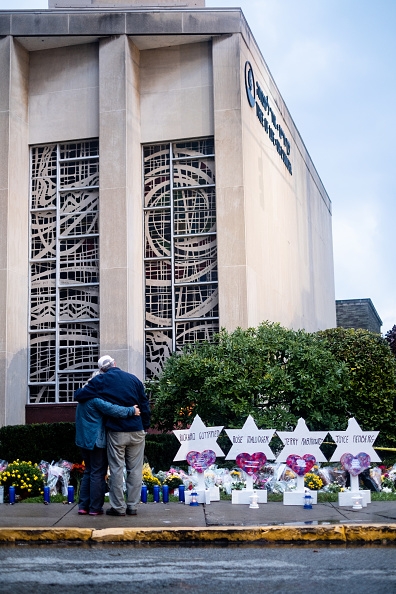You have /5 articles left.
Sign up for a free account or log in.

Mourners in front of Tree of Life Synagogue in Pittsburgh after mass shooting
Getty Images
It was Saturday morning, and I was trying to explain to my teenage son what had just happened in the Pittsburgh synagogue. My heart pounded as I tried to find the right words to explain yet another mass killing in our country in a way that wouldn’t leave him feeling unsafe.
He had already experienced lockdowns at his school, so he wasn’t shocked by the latest news. He was mostly curious about how our president had responded to the tragedy. I explained that he had expressed his concerns but also said that the synagogue should have had more security. We discussed the situation for a bit before he went on with eating his breakfast. I felt that I needed to do more, but I also knew it was probably best to watch and listen for his concerns, as some experts recommend.
As with parenting, life often comes at you fast as an academic administrator. Depending on your field, you are often faced with current events that have an impact on your teaching, or a broader impact on your campus. Several years ago, after a series of murders of young black men by the police, followed by the killing of five Dallas police officers during a Black Lives Matter march, I felt I had to take some kind of action as my college’s provost and a role model for our students.
My comment to the Menlo College online newsletter tried to address the issues while showing our willingness to reach out. “The past week has been a difficult one for our country and our community. As we work through the many issues that have been raised, we feel it is important that educational institutions like Menlo College reach out to our communities and find ways to work through these difficult issues with an open dialogue.” We had a meeting of students, staff members and community members that was modeled on the Difficult Dialogues program and other organized efforts to address concerns and anxieties without devolving into partisan disputes or finger-pointing.
Since then, the situation nationally has taken a notable turn for the worse, both in terms of discourse and violence. President Trump has been called out for comments that are considered inflammatory, particularly about the news media. The recent hearings for Brett Kavanaugh’s U.S. Supreme Court nomination raised a variety of issues related to sexual harassment and violence, leaving the country divided on whether or not he should have been confirmed. In the week of Oct. 22 alone, two African American people were shot by a white assailant after he had tried to break into a black church, bombs were sent to critics of Trump and 11 people were killed in a synagogue in Pittsburgh.
Social media has, in particular, become a place for viral attacks. But we should not overlook the fact that platforms like Twitter have also become sites for some reasoned dialogue. Historians like Kevin M. Kruse write long Twitter threads to debunk the many forms of disinformation that plague the platform. Another colleague, Todd Curry, has shared a video of a news clip after the assassination of John Lennon that he shows to his class without comment whenever a mass shooting occurs. He has already shown it five times this semester. Although social media has its problems, many faculty members are making good use of the medium. They are not only educating their own students but also providing a public service -- and they deserve more credit for it.
Meanwhile, college presidents and other administrators have been called upon to step in and make statements to address crises both on and beyond their campuses, as well as to provide new programming and services for students. For instance, as noted in Inside Higher Ed, several college presidents have refused to go along with the Trump administration’s call for changes in defining gender that would negatively impact transgender students. Even last February, University of Washington president Ana Mari Cauce wrote, “I want to reassure everyone on our campuses that at the UW, our support for trans and all LGBTQ students will not change.”
As tensions increase, students are increasingly in need of guidance and counseling, particularly in the wake of a horrific event like the shooting at the Tree of Life synagogue in Pittsburgh. Administrators, staff and faculty will all continue to face challenges in managing the ongoing events that have impacted our student populations in a variety of ways. Some students have become more involved with organizations and groups, while others have become more withdrawn. Regardless of the reaction, campuses need to be prepared to manage these difficult situations and learn from previous experiences. Those who work at colleges and universities must identify the practices that will best allow them to serve the wide array of students during the increasingly complex and difficult situations that will undoubtedly come.
Having crisis management plans at this time is crucial. Administrators need to share with faculty and staff the ways that they plan to deal with a variety of challenging -- and perhaps even violent -- situations and circumstances on their campuses. In another article in Inside Higher Ed, officials at the Citadel defined their way of crisis management as: “Transparency. Core values. And practice -- lots of it.” I couldn’t agree more.
Numerous resources are available for managing crises, including off-site training for presidents and provosts. The American Council on Education, for instance, maintains a website on security and crisis management. Administrators and faculty members should review such resources and educate themselves. Unfortunately, in this era of division and tumult, we all must hope for the best but prepare for the worst.








